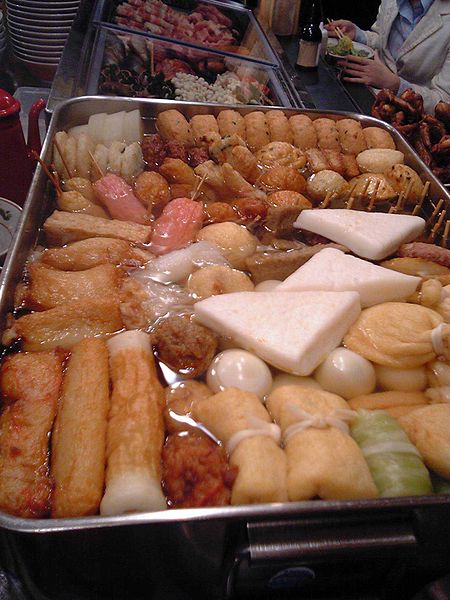This article needs additional citations for verification. (October 2021) |
Oden (おでん, 御田) is a type of nabemono (Japanese one-pot dishes) consisting of several ingredients such as boiled eggs, daikon or konjac, and processed fishcakes stewed in a light, soy-flavored dashi broth.
 Oden stewing at an oden stall | |
| Type | Soup |
|---|---|
| Place of origin | Japan |
| Main ingredients | Boiled eggs, daikon, konjac, fishcakes, soy-flavored dashi broth |
| Other information | Unicode emoji 🍢 |
Oden was originally what is now commonly called miso dengaku or simply dengaku; konjac (konnyaku) or tofu was boiled and eaten with miso. Later, instead of using miso, ingredients were cooked in dashi, and oden became popular. Ingredients vary according to region and between each household. Karashi is often used as a condiment.
Oden is often sold from food carts, though some izakayas and several convenience store chains also serve it, and dedicated oden restaurants exist. Many different varieties are sold, with single-ingredient dishes sometimes as cheap as 100 yen. While it is usually considered a winter food,[1] some carts and restaurants offer oden year-round. Many of these restaurants keep their broth as a master stock, replenishing it as it simmers to let the flavor deepen and develop over many months and years.[2]
Regional variations
editJapan
editIn Nagoya, it may be called Kantō-ni (関東煮) and soy sauce is used as a dipping sauce. Miso oden is simmered in hatchomiso broth, which tastes lightly sweet. Konjac and tofu are common ingredients.
In the Kansai area, this dish is sometimes called Kanto-daki (関東炊き) and tends to be more strongly flavored than the lighter Kantō version.[3]
Shizuoka oden uses a dark-colored broth flavored with beef stock and dark soy sauce, and all ingredients are skewered. Dried and ground fish (sardine, mackerel, or katsuobushi) and aonori powder are sprinkled on top before eating.
Udon restaurants in Kagawa Prefecture in Shikoku almost always offer oden as a side dish, to be eaten with sweet miso while waiting for udon.
-
Typical oden ingredients
-
Oden store at Sunpu Castle Park in Shizuoka City
Outside Japan
editChina
editIn China, 7-11 markets oden as haodun (好炖) a word play on "good pot".
South Korea
editIn South Korea, the loanword odeng (오뎅) borrowed from Japanese oden is a synonym of eomuk[broken anchor] (fishcakes).[4] The boiled dish consisting of fishcakes is called by the names such as odeng-tang (오뎅탕) or eomuk-jeongol (어묵전골), with the words such as tang (soup) or jeongol (hot pot) attached to the ingredient name. The street food version is sold from small carts and is usually served with a spicy soup. It is very common on the streets of South Korea and there are many restaurants that have it on the menu or specialize in it.
Taiwan
editOden was introduced to Taiwanese cuisine during Japanese rule and is referred to in Taiwanese Hokkien as olen (Chinese: 烏輪; Pe̍h-ōe-jī: o͘-lián),[5] which has been further loaned into Taiwanese Mandarin as hēilún (Chinese: 黑輪).[6] Tianbula (Chinese: 甜不辣; pinyin: tiánbùlà; lit. 'sweet', ' not spicy')[7] is a common ingredient for oden and is a popular snack at night markets. Tianbula is actually Japanese satsuma-age and was introduced to Taiwan by people from Kyushu (where satsuma-age is commonly known as tempura) when Taiwan was under Japanese rule.[8][9] Besides the more traditional ingredients, the Taiwanese olen also uses many local ingredients, such as pork meatballs and blood puddings. More recently, oden is offered in convenience stores where it is sold as guāndōngzhǔ (關東煮), the Mandarin reading of the Japanese characters for Kantō-ni.
Trivia
editSee also
editReferences
edit- ^ Itoh, Makiko (January 20, 2017), "'Oden': Japan's traditional winter fast food", The Japan Times
- ^ Mishan, Ligaya (7 June 2018). "At Davelle, a Son of Hokkaido Puts Luxury in Reach". New York Times. Retrieved 22 September 2018.
- ^ 関西ではなぜおでんを「関東煮」と呼ぶのか? [Why Oden is called 'Kanto-ni' in Kansai?] (in Japanese). Nikkei. February 2, 2013.
- ^ "Fish cake: a must-eat snack". Korea.net.
- ^ "Entry #31111 (oo33 lian51)". 臺灣閩南語常用詞辭典 [Dictionary of Frequently-Used Taiwan Minnan]. (in Chinese and Hokkien). Ministry of Education, R.O.C. 2011.
- ^ "黑輪". 教育部重編國語辭典修訂本. Ministry of Education, R.O.C. 2015.
- ^ "Entry #31159 (thian35 pu55 lah3)". 臺灣閩南語常用詞辭典 [Dictionary of Frequently-Used Taiwan Minnan]. (in Chinese and Hokkien). Ministry of Education, R.O.C. 2011.
- ^ Katakura, Yoshifumi [in Japanese] (2016). "片倉佳史の台湾歴史紀行 第一回 港湾都市・基隆を訪ねる" (PDF). Japan–Taiwan Exchange Association. p. 9. Archived (PDF) from the original on 2022-10-09. Retrieved March 23, 2020.
- ^ "「さつま揚げ」の各都道府県での呼び名を調査 関西は「天ぷら」". J-TOWN.NET. June 16, 2017. Retrieved March 23, 2020.